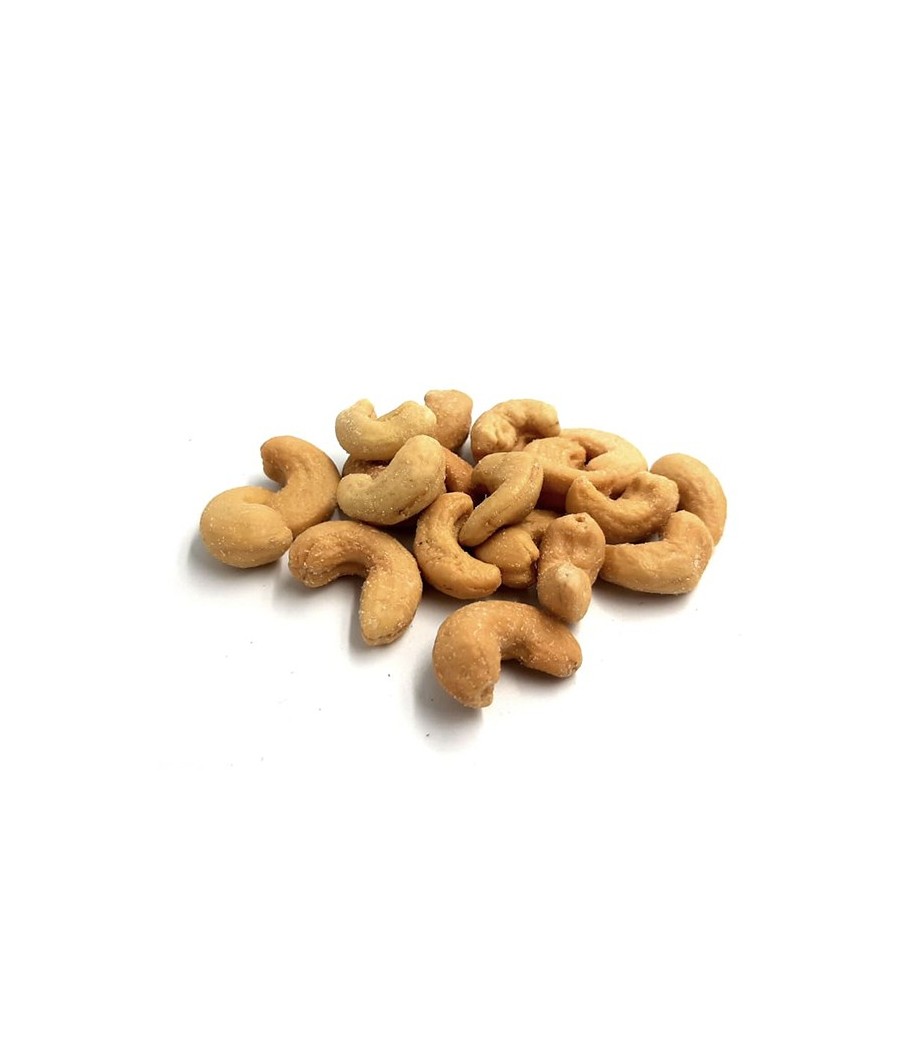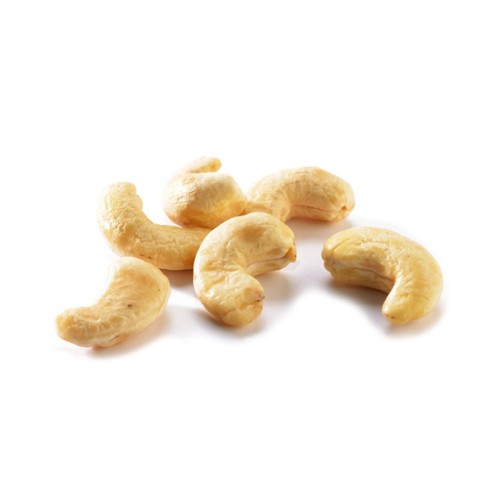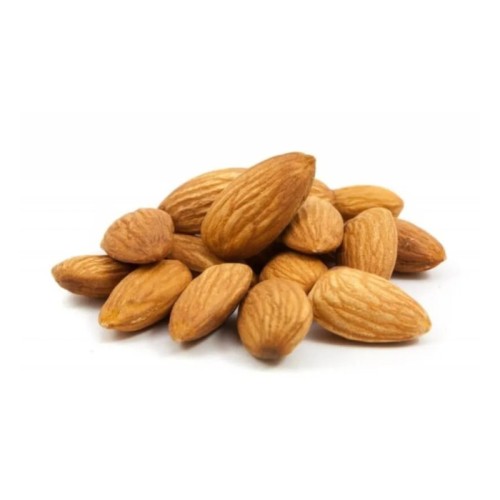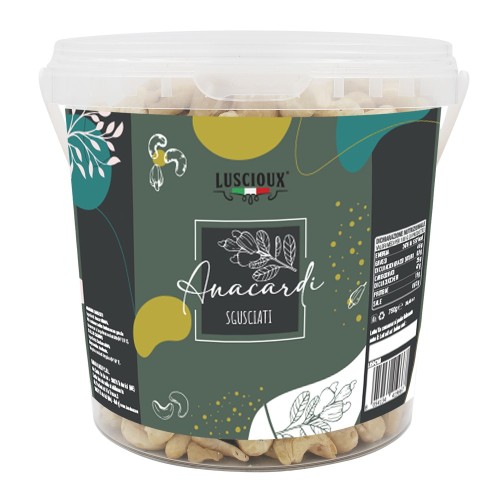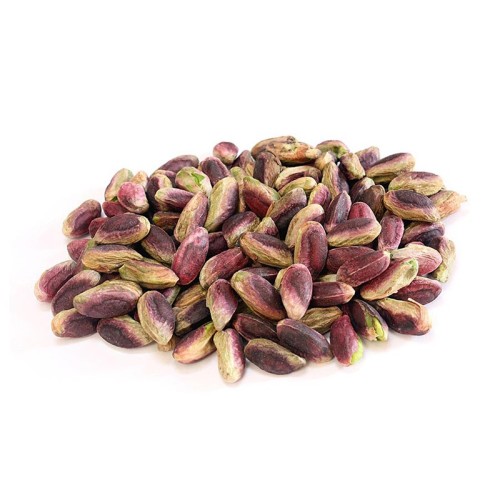Roasted and Salted Whole Cashew
(€18.93 Per Kg)
 Security policy
Security policy
Transparency and reliability - Encrypted information (SSL Certificate)
 Delivery policy
Delivery policy
Fast shipping with delivery in 1- 4 working days.
 Return policy
Return policy
24/7
Roasted and salted cashews are among the most popular snacks in the world, perfect for aperitifs, but they also lend themselves well in the kitchen. Roasted and salted cashews are among the most popular snacks in the world, perfect for aperitifs, but they also lend themselves well in the kitchen. They are rich in nutrients and vitamins.
Data sheet
- Product
- Cashew
Specific References
- ean13
- 8054134417748
Nutritional values
| Ingredients | CASHEW NUTS. May contain traces of PEANUTS and other NUTS. |
| Method of conservation | Keep in a cold and dry place. |
| Nutrition declaration | average values per 100 g: |
| Power | 2532kJ / 611kcal |
| Fats | 48 g |
| of which saturated fatty acids | 9 g |
| Carbohydrates | 22 g |
| of which sugars | 7.60 g |
| Fibers | 5.3g |
| Protein | 20g |
| Salt | 1.20 g |
| Phosphorus | 546 mg (78% NRV*) |
| Manganese | 1.8mg (90% NRV*) |
| Selenium | 39 μg (71% NRV*) |
| Directions | The advice given IS NOT IN ANY WAY TO BE CONSIDERED OF MEDICAL/PRESCRIPTIVE VALUE. The information provided is for informational and informative purposes only, therefore they are not intended in any way to replace medical advice. In the presence of pathologies you should always consult your doctor. |
| Origin | Vietnam |
| Nutrients | Phosphorus, Manganese, Selenium |
| Vnr | *Nutritional Reference Value |
| Label and packaging | The images are included for illustrative purposes, the product may undergo changes based on stock availability and the selected weight. |
| Product | Cashew nuts |
Curiosity
The cashew is one of the few species that is grown starting from the seed even if the propagation can be done by grafting, layering or offshoots. The cashew seed germinates little and slowly therefore it is necessary to plant more seeds in the same planting site and subsequently thin out. The seed must be planted in situ as young plants are not easily transplanted. The distance between one plant and another is 10x10 meters at the beginning, then it is increased to 20x20 meters after about 10 years, with a maximum density of 250 plants per hectare. In the three years necessary to start production, the low branches and suckers are cut off the young plants.
In the producing countries , instead of the seed, the false fruit is eaten which is eaten fresh or transformed into jam. In Brazil, during the harvesting season, a juice is extracted from the fruit, which has a sour and refreshing taste, which can be drunk as it is (Brazil cajuado) or as wine after fermentation. From the cashew seed it is possible to obtain, with a yield of 45%, a fine edible oil of a light yellow color similar to almond oil. The cnsl is extracted from the shell and has many uses, it is used for the production of brake linings, clutch discs, waterproof paints and plastic materials. From the plant a timber is obtained, appreciated for its insect-repellent properties, used for the production of furniture, boats and crates. A gum is extracted from the trunk and used to replace gum arabic.
The tree is an evergreen that grows up to 10-12 m in height, of which the largest extant specimen is found in Natal, Rio Grande do Norte, Brazil, with an area of about 7,500 square meters. The cashew plant is frequently found in coastal areas both in warm temperate climate regions and in dry tropical climate areas and also in equatorial rainforests. The harvest takes place during the dry season: the ripe fruits that fall from the branches are piled up and left to dry on the ground for a few days, during which it is very important that the climate is dry.
Cashews, unlike other oily nuts, contain about 10% of their weight in starch . This makes it a good thickener for watery dishes such as soups, meat stews, and some milk-based Indian desserts. Many Asian cuisines use cashews instead of other nuts because of this unusual characteristic.
Cashews are commonly used in Indian cuisine : whole, to garnish desserts and curry dishes, or ground into a paste, base of curry sauces (e.g. korma) or in some desserts (e.g. kaju barfi). In Goan cuisine, raw or roasted cashews are used whole to prepare curries and desserts.
The indigenous population of cashew-producing countries uses many parts of the plant for the preparation of medicinal substances and insect repellent lotions.
The fats and oils in cashews are 54% monounsaturated fat (18:1), 18% polyunsaturated fat (18:2), and 16% saturated fat (9% palmitic acid (16:0) and 7% stearic acid (18:0)). The ratio is therefore in favor of monounsaturated fatty acids generally considered "good", as they favor the replacement of LDL cholesterol present in the blood, the cause of heart attacks and vascular obstructions, with HDL cholesterol, which does not represent a source of danger for the 'body. Cashews are an excellent source of Vitamin K (100 g of natural cashews provide 40% of the reference nutritional value) which contributes to regular blood clotting and the maintenance of healthy bones. Cashews are also a good source of minerals such as copper, phosphorus and zinc.
For some people, cashews can give allergic reactions, and moderate consumption is also recommended for those who tend to suffer from kidney stones. Many parts of the plant are used in the traditional medicine of the Patamonas of Guyana. They grind the seeds into a poultice for treating snakebites, apply the nut oil to cracked heels or as an antifungal agent, and use the fruit, bark and leaves for many other purposes including for wounds and rashes. skin, as an antipyretic and against diarrhea1,2.
Literature reports that the petroleum ether and ethanol extracts of cashew leaves inhibit the growth of numerous species of bacteria and fungi2.
In one study, some chemical compounds identified in cashew shell oil were evaluated and were evaluated as effective against Streptococcusmutans, a bacterium responsible for many dental caries, and other Gram-positive bacteria3.
The cashew nut is included in the list of food allergens (Annex 2 section III of Legislative Decree 109/1992 and subsequent amendments).
1 DeFilipps RA, Maina SL, Crepin J. (surmised) (2007 (surmised)). "MedicinalPlants of the Guianas (Guyana, Surinam, French Guiana)". Smithsonian Institution.
2 Akash P. Dahake, Vishal D. Joshi, Arun B. Joshi (2009). "Antimicrobial screening of different extracts of Anacardium occidentalis Linn. Leaves". International Journal of ChemTechResearch 1(4):856–858.
3 MasakiHimejima, IsaoKubo (February, 1991). "Cashewoilmay conquer quercavities". Journal of Agricultural and Food Chemistry 39(2):418–421.
Sources:
https://en.wikipedia.org/wiki/Cashew
Nutspaper “Cashew” 1/2007
History
The English name for cashew comes from the Portuguese caju, which in turn comes from the indigenous Tupi name, acajú. The name Anacardium refers to the shape of the fruit which resembles an inverted heart (ana means "upwards" and cardium "heart"). In the Tupi languages, acajú means "nut that produces itself".
The cashew plant is native to northeastern Brazil (Amazon basin) but is widely cultivated in tropical regions around the world. The Portuguese discovered it in 1578 and in the 16th century introduced it to the western coasts of India and the eastern regions of Africa. To date it is grown in 32 countries therefore the harvest time varies from country to country. Anacardiaceae are an important family of dicotyledonous flowering plants, belonging to the order Sapindali. The genus, which gave its name to the family, is Anacardium, which includes eight species of tropical trees native to South America, among which the best known is the cashew nut (Anacardium occidentalis).
The cashew provides two types of fruit : a fresh one, which is actually, from a botanical point of view, a false fruit, and a dried one, the almond or cashew nut. As it develops, the cashew apple can take on a variable color between yellow and red and a vaguely heart-shaped appearance, from which the name of this plant derives. The cashew nut, the true fruit, is a kidney-shaped nut (about 3cm long and 2.5cm wide) that grows on the lower outer part of the false fruit and is provided with a hard pericarp containing the edible seed consisting of 2 white cotyledons and a small embryo. Cashew is grown commercially in 32 countries around the world. The main producers are India, Africa (particularly Nigeria, Tanzania, Ivory Coast, Guinea Bissau, Mozambique and Benin), Vietnam, Brazil and Indonesia.
Sources:
https://en.wikipedia.org/wiki/Cashew
Nutspaper “Cashew” 1/2007
storage
You can store whole cashews in cool, dry places away from heat and humidity. Here are 4 useful tips:
- The ideal condition for keeping natural cashews is in a refrigerated environment. Cashews can also be stored without problems at room temperature during the winter season given the low temperatures. During the summer, on the other hand, it is advisable to keep it in the fridge or in the coolest possible places, as the increase in temperatures could favor the deterioration of the products.
- The ideal container in which to store cashews is glass . In fact, thanks to its constitution it is impenetrable to chemical and gaseous agents, and having excellent thermal insulating capacity it maintains the initial temperature for a longer time compared to other materials. If the glass is colored, all the better: using colored glass prevents the entry of some wavelengths of light (including ultraviolet light) and therefore some nutritional and organoleptic characteristics remain unaltered.
- The type of closure of the container is also important: an airtight cap ensures that the food is protected from excessive contact with oxygen which can lead to lipid oxidation and which can be essential for aerobic bacteria.
- The environment should always be well ventilated : by ventilating the rooms, the internal humidity that escapes from the window is kept under control, guaranteeing the right balance, which helps to discourage the onset of moulds.
Recommended doses
30 g of cashews provide:
- 27% of the nutritional reference value of Manganese;
- 23% of the reference nutritional value of Phosphorus;
- 22% of the nutritional reference value of Selenium.
Individual needs vary according to age, gender, weight and physical activity. A varied and balanced diet and a healthy lifestyle are the basis of your well-being.
Property
100g of natural cashews contain:
- Vitamin B6 (0.34 mg – 24% NRV)
- Vitamin E (3.0 mg – 25% NRV)
- Biotin (14 μg – 28% NRV)
- Potassium (665 mg – 33% NRV)
- Vitamin K (30 μg – 40% NRV)
- Iron (5.8 mg – 41% NRV)
- Thiamine (0.53 mg – 48% NRV)
- Zinc (4.9 mg – 49% NRV)
- Magnesium (250 mg – 67% NRV)
- Selenium (39 μg – 71% NRV)
- Phosphorus (546 mg – 78% NRV)
- Manganese (1.8 mg – 90% NRV)
- Copper (1.9 mg – 190% NRV)
- Protein (19g)
- Fiber (3.3 g)
- Unsaturated fatty acids (38 g), monounsaturated (29 g) and oleic acid (29 g).
Please note that cashews are included in the list of allergens (Annex 2 EU Reg. 1169/2011 and subsequent amendments)
No customer reviews for the moment.

